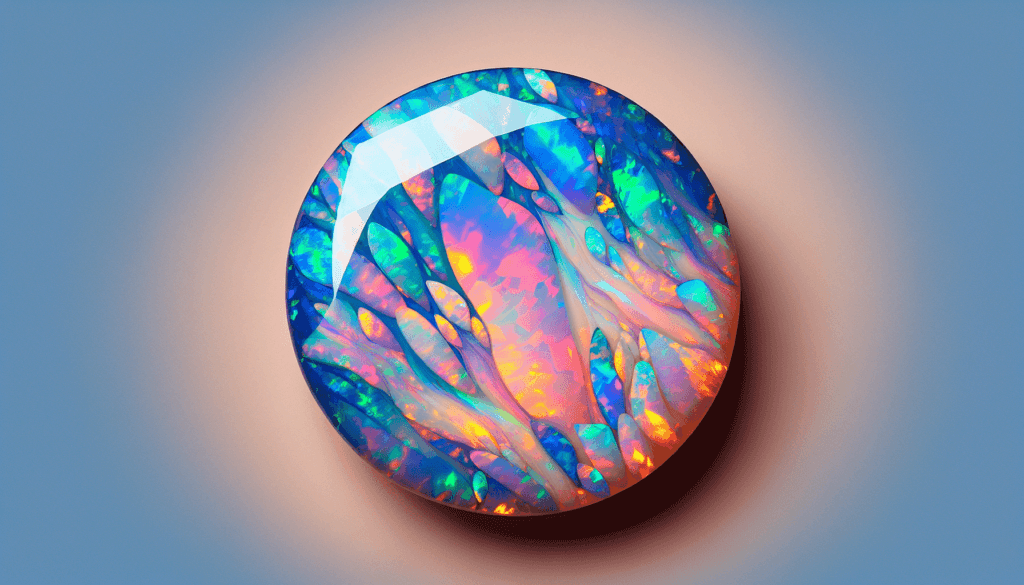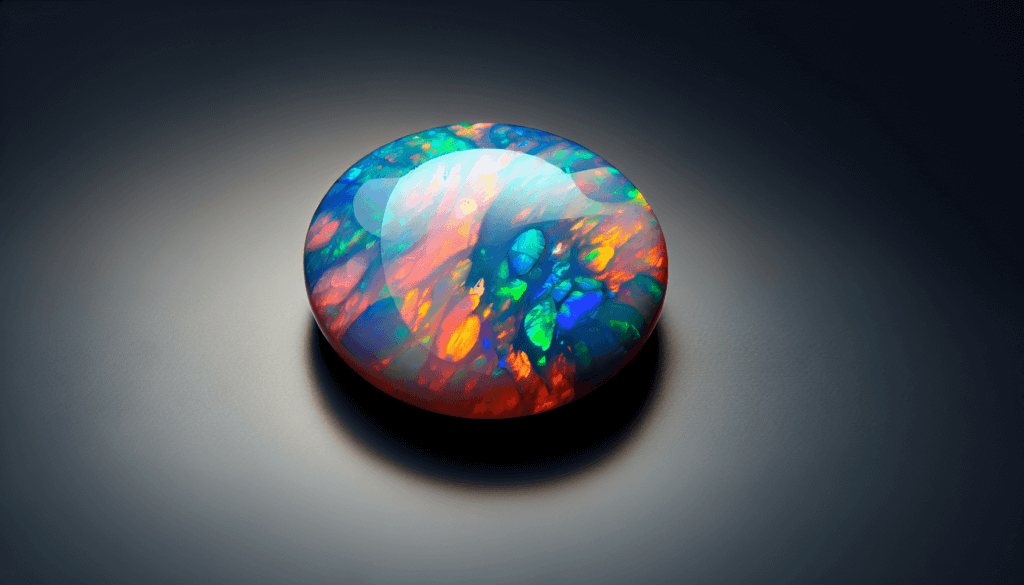Ever wondered about the rarity of the sparkling gemstone, the opal? The opal, with its captivating play of colors, has piqued the interest of many gem enthusiasts around the world. “Is A Opal Rare?” explores the fascinating facets of this precious gem, from its formation process to its value in today’s market. As you journey through this insightful article, you’ll gain a deeper appreciation for the unique rarity and bewitching charm of the opal.

Understanding What Opal Is
Basic definition of opal
Opal is an extremely captivating precious gemstone. It’s been adored and appreciated throughout the ages for its remarkable play of color. Opals are indeed a unique blend of silica and water; they exist in a non-crystalline form, which is unusual for gemstones. They’re amorphous, meaning they do not have any definite shape or visible crystalline structure.
Description of opal’s physical properties
Opals possess a host of fascinating physical properties. One of its most unique properties is its color spectrum. The term “play-of-color” is used to describe the flashing or shimmering movements of iridescent color within the gemstone. Asides from this, opal has a hardness equivalent to glass, which equates to a measurement of 5.5 – 6.0 on the Mohs scale.
Major types of opal
There are several types of opals, each with distinctive features. This includes the well-known white or milky opals renowned for their pale body tone and vibrant play-of-color. There are also black opals known for their striking dark body tones, which make the colors appear much brighter, hence their high value. Other types include Fire opals with their translucent to transparent body and a warm body tone, and Boulder opals, which usually include parts of the surrounding rock matrix, enhancing their unique look.
World Distribution of Opal
Countries where opal is commonly found
Opal is found in several regions across the globe. Australia reigns supreme as the largest producer; this country provides over 85% of the world’s opals. Other countries where opal is found include Ethiopia, Mexico, Brazil, United States (primarily Nevada and Idaho), Honduras, and Slovakia.
Understanding why opal is abundant in these regions
The abundance of opal in these regions can be traced back to geological reasons. Opals require a specific set of conditions to form. They are sedimentary rocks found in regions where a lot of silica was dissolved in ancient groundwaters, which then formed a gel that solidified either in open cavities in the rocks or permeated other rocks. Such conditions were prevalent in the listed countries, hence their opal abundance.

Different Types of Opal and Their Rarity
Describing commonly found types of opal
Opals are diverse, with some types being more common than others. White opals, for instance, are quite prevalent. They present body tones from colourless and very light gray or blue, through the spectrum to tan and darker browns. Fire opals, known for their bright orange or red body, are also quite common, especially within areas of Mexico. Boulder and Crystal opals also aren’t too rare to come by.
Exploring the rarest types of opal
On the flip side, the most valuable and rarest type of opal is the black opal. These opals exhibit a variety around dark grey, olive black or black body tones. Their darkest shades provide a stunning color play, which is a sight to behold. Another relatively rare type is the Matrix opal, which is found as infillings or tiny pores within the host rock.
Factors That Determine Opal Rarity
Importance of color in assessing rarity
Color plays a significant factor in determining opal rarity. Having an illuminated and good mix of colors, especially red (since red requires the largest spheres of silica), tends to increase the opal’s value. Black opals tend to be extremely valuable because their dark body tones highlight the spectral colors in a striking manner.
Role of pattern and size in determining rarity
The pattern and size of an opal are also critical factors for assessing rarity. The larger the opal stone and the more unique or complex the pattern, the more likely it is to be deemed rare and valuable. Regular and close packed patterns are often highly coveted when it comes to opal’s value and rarity.

Opal Mining and Its Effect on Opal Rarity
Understanding how opal is mined
Opal mining is conducted in a myriad of ways, which varies depending on the region and the formed rock type. Methods may range from simple hand mining, where miners dig holes into the earth to reach the opals, to more complex methods deploying drills and explosives.
Discussion on how mining affects opal rarity
The process of mining significantly affects the rarity of opal. Over-mining risks depleting opal reserves, hence increasing their scarcity. Further, the mining process poses a risk of damaging the gemstones if not done correctly.
Black Opal: The Rarest Type of Opal
Description of black opal
Black opal is an extraordinary type of opal with a dark body tone that ranges from dark grey to black. It showcases a brilliant play of spectral colors against its dark background, making it quite captivating.
Why black opal is considered rare
Black opal is considered the rarest form of opal due to its unique properties. The stark contrast between the spectral hues and the black body greatly amplifies the visibility and vibrancy of the colors. This enhances their desirability and consequently their rarity.
Locations where black opal is mined
Black opal is primarily mined in Australia, specifically in the town of Lightning Ridge, which has quickly become the Black Opal capital of the world due to its rich deposits.
Opal Imitations and Synthetic Opals
Understanding what opal imitations are
Opal imitations are man-made materials crafted to look like opal. They are created using materials such as glass, plastic, or resin. These materials are typically dyed or painted to emulate the play-of-color unique to opal.
How synthetic opals are made
Synthetic opals, on the other hand, are opals that are lab-grown using similar conditions to those found in nature. The process involves silicic acid gel being deposited in a controlled environment at low temperatures over a lengthy duration, which results in the formation of spheres of silicon dioxide.
Distinguishing real opals from imitations and synthetics
Real opals can usually be distinguished from imitations or synthetics by their unique color play and the fluid movement of the spectral hues. Genuine opal’s color play will often be broad and covering the entire surface, while imitations or synthetics may show ‘too perfect’ or ‘unnatural’ patterns.
Economic Impact of Opal Rarity
Effect of opal rarity on its market value
Opal rarity significantly impacts its market value. As with most precious gems, the scarcer a type of opal is, the higher its likely market value. The value of opal also rises due to factors like the brilliance of its play-of-color, size, and pattern.
Role of opal mining in local economies
Opal mining plays an integral role in supporting local economies. Australia, as the world’s largest opal producer, derives significant income and employment from opal mining. Similarly, countries like Ethiopia and Mexico also reap economic benefits from their opal mining industries.
Preserving Opal Rarity: Opal Conservation Efforts
Discussion on conserving opal mines
Conserving opal mines is of utmost importance to preserve the rarity of opal. This involves regulating mining activities to prevent over-exploitation of opal deposits, as well as employing sustainable and environmentally friendly mining methods.
Role of government and non-profit organizations in opal conservation
Government institutions and non-profit organizations play a crucial role in opal conservation. Governments need to enact robust policies that control opal mining activities and encourage sustainable practices. Non-profit organizations can help by raising awareness, supporting research, and advocating for conservation laws at different levels.
Future of Opal: Mining Innovations and Their Potential Impact on Rarity
Possible future directions for opal mining
Future innovations in opal mining might revolve around further improving equipment and methods for extracting opal. This could not only increase efficiency but could also minimize the risk of destroying the opal during the extraction process.
Potential consequences on opal rarity owing to technological advancements
On the downside, technological advancements could mean that opals become more accessible, hence less rare. However, improving efficiencies might also allow mining companies to prolong the life of opal mines, effectively maintaining – or even enhancing – the gem’s rarity in the long term. As such, future trends in opal mining will inevitably influence rarity and, by extension, the complex allure of this unique gemstone.



